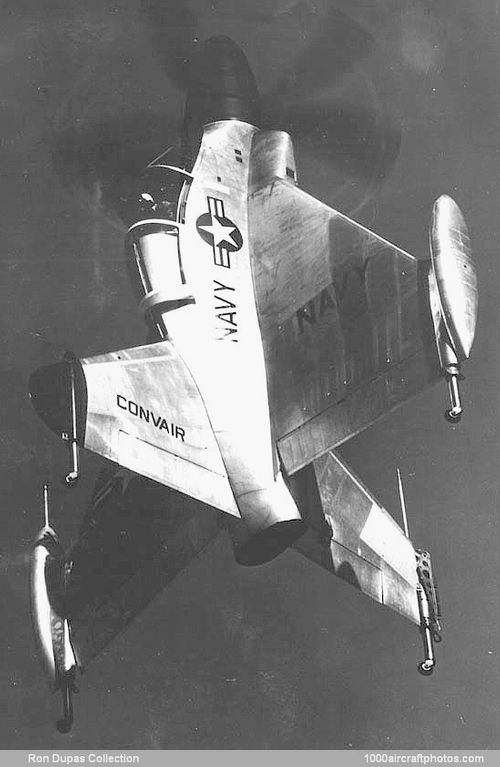07/31/2016. Remarks by Johan Visschedijk: "Following the capture of data from German studies into the possibility of vertical take off and landing (VTOL) both the USAAF and USN issued study contracts to industry in 1947. A year later, the Navy organized a more specialized study for VTOL fighters capable of operating off platforms mounted on the afterdeck of ordinary cargo ships and in 1950, this was converted into a requirement for research aircraft capable of development into operational convoy escort fighters. In March 1951, three examples (BuNos. 138648 to 138650) of a Convair submission were ordered, along with a contract for the similar Lockheed XFV-1 design.
The Convair XFY-1, nicknamed "Pogo", was a tail-sitting design with a short fat fuselage with stubby delta wings and a pair of large vertical fins above and below the fuselage. The ventral fin was jettisonable to permit an emergency landing in conventional wing-supported mode, and the assembly rested on small castoring wheels at the tips of the wings and fin. On take off, the Pogo was to ascend vertically, then nose over into a conventional attitude. To land, the aircraft was flown into a nose-high position, then allowed to descend under gradually reduced power.
For the XFY-1, Allison coupled two T38 propeller-turbines to make the 5,850ehp Allison YT4O-A-6 which drove Curtiss-Wright 16 ft (4.88 m) coaxial, contra-rotating, turbo-electric propellers. The cockpit, reached, with considerable difficulty, via an oddly-shaped special ladder, had the single ejector seat mounted on gimbals to tilt 45° when the aircraft was in a vertical position. The proposed armament comprised four 0.787 in (20 mm) cannons or 46 2.75 in (70 mm) folding-fin aircraft rocket (FFAR) projectiles.
In order to prepare James F. 'Skeets' Coleman to fly this unique aircraft, a simulator consisting of an engine and fuselage section that could rise five feet when tethered to a test stand was completed. A prototype (BuNo. 138649) was then attached to an elaborate system of cables and tension regulators running to a powered drum mounted under the 184 ft (56 m) roof of a hangar at NAS Moffett, California. This restraint allowed the aircraft to rise and fall freely, but limited lateral displacement.
During summer 1954, Coleman made many short vertical 'flights' in the hangar then on August 1, made the first untethered vertical flight to 40 ft (12 m). Over the next two days, the XFY-1 was flown up to 150 ft (46 m), then returned to San Diego for further tests at NAAS Brown Field. On November 2, 1954, the first transition to horizontal flight was made, hence the XFY-1 became history's first VTOL craft to take off in the vertical mode and successfully transition from flight sustained by its engine thrust to wing-borne flight. It cruised for 20 minutes before returning and landing in a 50 ft (15 m) square. Flights were also made from Lindbergh Field and for these, the first successful VTOL flights ever (other than by helicopter or autogyro) Coleman was awarded the Harmon Trophy.
Although ostensibly self-reliant, in the XFY-1 tests required inordinate amounts of support equipment including elaborate dollies and platforms in both vertical and horizontal modes. Furthermore, the XFY-1 proved extremely difficult to land safely on a consistent basis, and coupled with confusing hovering controls, inadequate pilot's view of the landing area, unusual pilot's posture, ejection danger, and questionable reliability of the XT-40 propeller-turbine (the same engine used on the R3Y Tradewind) led to the program's cancellation after 40 hours of flying.
One airframe (BuNo. 138648) was used as an engine test bed and the third (BuNo. 138650) for static tests and neither was flown. However the other, previously displayed at NAS Norfolk, is currently stored at NASM's Paul Garber restoration facility in Maryland."
